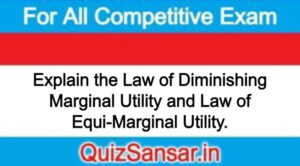
Explain the Law of Diminishing Marginal Utility and Law of Equi-Marginal Utility.
Explain the Law of Diminishing Marginal Utility and Law of Equi-Marginal Utility.
Ans.
Law of Diminishing Marginal Utility
A law of economics stating that as a person increases consumption of a product – while keeping consumption of other products constant – there is a decline in the marginal utility, that person derives from consuming each additional unit of that product. This law is known as Law of Diminishing Marginal Utility.
The law of diminishing marginal utility states that as more units of a good are consumed, additional units provide less additional satisfaction than previous units i.e. marginal utility eventually falls and can become negative beyond a certain point. The point at which MU becomes negative will vary according to good and individual. This explains a general principle that has much wider application in economics.
The “Law of Diminishing Marginal Utility” states that for any good or service, the marginal utility of that good or service decreases as the quantity of the good increases, other factors remaining constant. In other words, total utility increases more and more slowly as the quantity consumed increases. This is “diminishing returns” from the viewpoint of the consumer, and is a general principle of economics. There might be a threshold before the principle applies. For example, the marginal utility of golf clubs might increase until you have a fairly full set. But beyond some threshold, marginal utility will diminish with increasing consumption of any good.
For example, suppose you absolutely love PEPSI. So you go to a Sale point and order one PEPSI. That PEPSI gives you 30 utils (units measuring utility) of satisfaction. You finish off that PEPSI while still standing at the counter. The cashier asks if you want another. “Sure!” you say and buy another – but this gives you only 23 utils. You drink this PEPSI in about five minutes, when the cashier asks if you want yet another. You order for another one and this one however only gives you 4 utils. This particular PEPSI takes awhile to finish with several moments where you stop to let things settle. Now you’re full. When you finish this third Pepsi, the cashier yet again asks you if you’d like another. Well, considering you’ve spent almost all your money, are really full and this time you do not enjoy any more. Rather, it seems like a burden to you. Thus, your marginal utility from the next PEPSI would be negative.
Law of Equi-Marginal Utility
Prof. Alfred Marshall has stated the law as follows- a person has a thing which can be put to several uses he will distribute it between these uses in such a way that it has the same marginal utility in all. In other words he will substitute a commodity of greater utility for a commodity of lesser utility, a person derives maximum satisfaction, when the marginal utilities of all the commodities purchased by him are equalised.
The Law of Equi-Marginal Utility explains the behaviour of the consumer when he sends his limited income on various commodities. Every consumer will allocate his resources in such a way that he get maximum satisfaction and obtain equilibrium.
In practice, the consumer is spending his income among many goods and services that are available to him to buy. A consumer with fixed income and the given market prices of different goods can only get maximum satisfaction only if he acts on the basis of law of equi-marginal utility.






